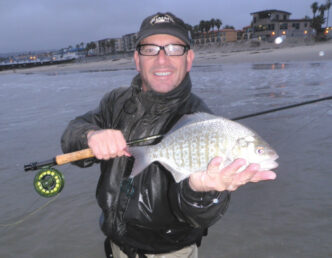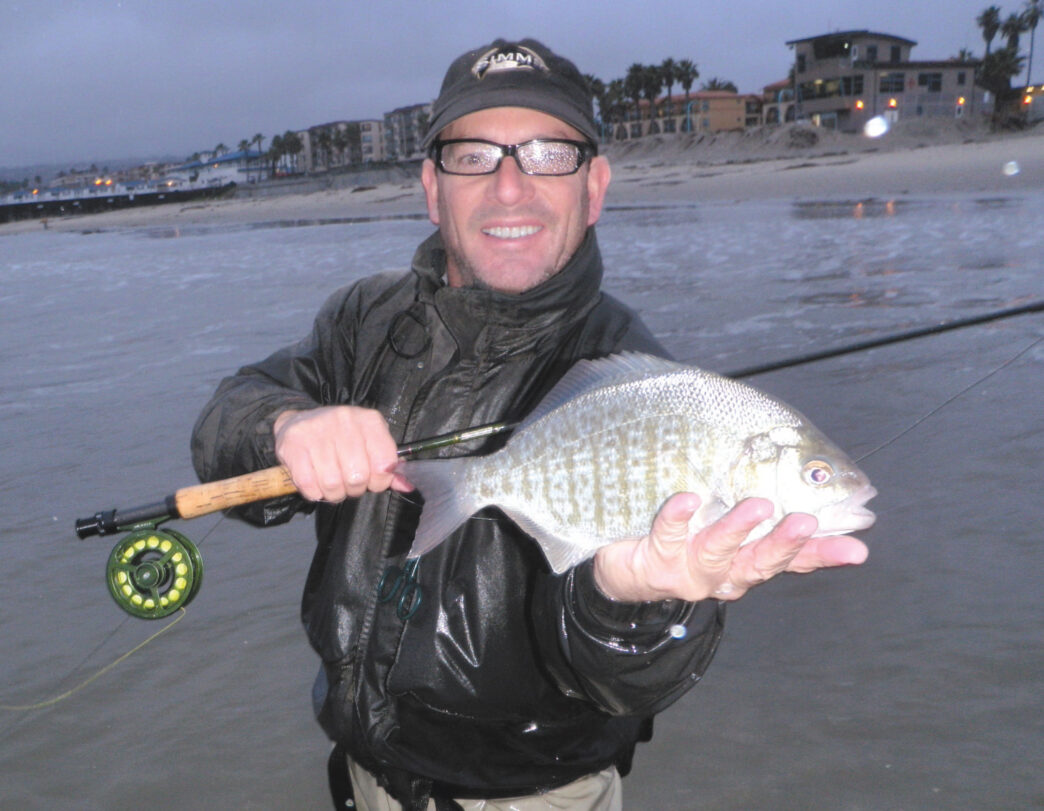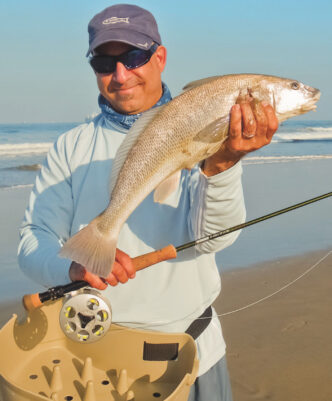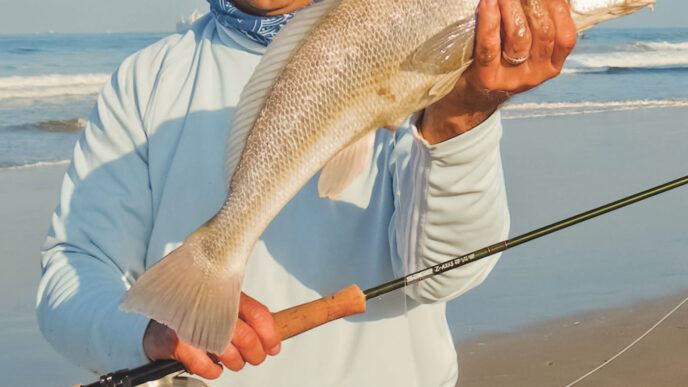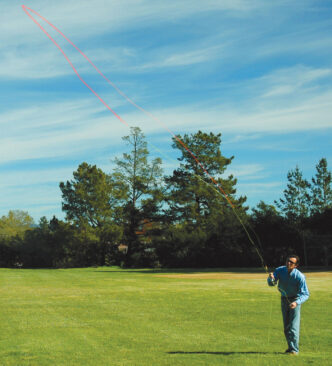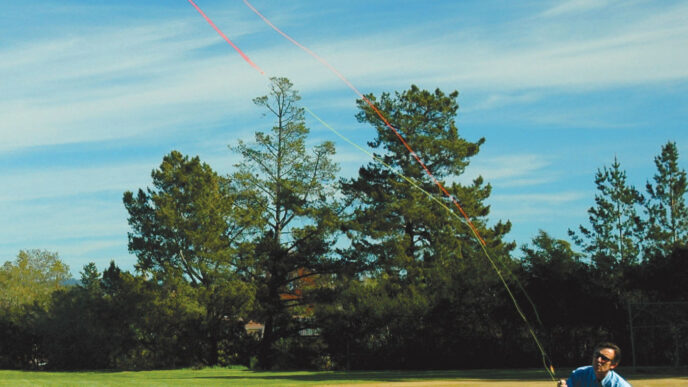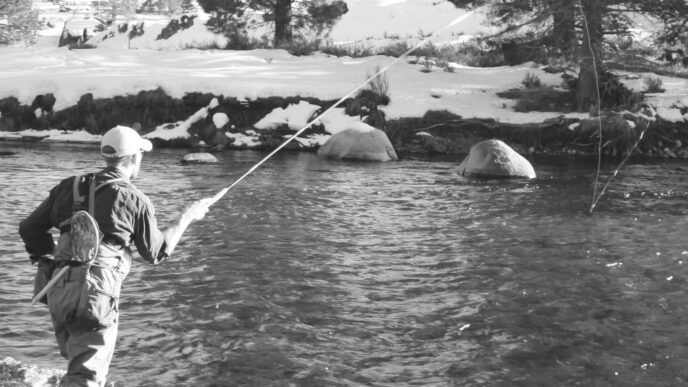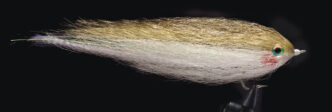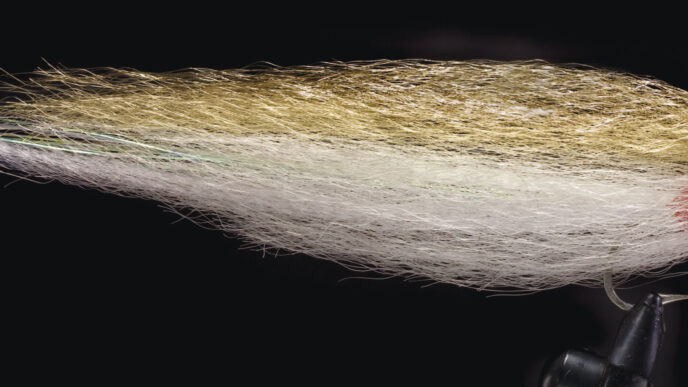Anglers unfamiliar with surf fishing often have trouble figuring out how to get started. The water looks uniform and consistent, offering few clues as to where to begin casting. Those certainly were my thoughts when I first came to San Diego and started fishing the beach. I felt as if I were staring at acres of water without a clue as to where or when to cast, or how to get my fly in front of a fish, or what equipment and flies to use, or pretty much anything.
It took me a lot of trial and error to get my feet wet in the surf as a fly fisher. Well, not literally — I usually prefer to wear waders — but learning the ins and outs of fly fishing the surf zone reminded me of being a kid and learning to fish for trout. When we were growing up, my friend Mike Costello and I fished the local streams pouring off the San Bernardino Mountains, but didn’t have the luxury of having a guide show us how to read a stream or where to locate fish. So, armed with our fishing rods and tackle boxes, we had no choice but to teach ourselves, and we did it by fishing every inch of those streams. Over the countless days, months, and years, we learned a lot about reading the water and where fish were — or more importantly, where they were not.
Using the same “just fish everything” technique when I started fishing the surf, I began to see subtle clues to water and wave behaviors. I could decipher the shape and structure of the bottom by watching the surface of the water. Like a trout stream, the beach contains pockets, holes, cuts, troughs, seams, and drop-offs. These places all hold fish, and specific surface action and configurations reveal their presence. Knowing what clues to look for in relation to wave behavior, water movement, and hydraulic activity and knowing how to spot those clues is really the most important element to success when fishing off the beach. Once you understand these factors, you can tailor your equipment and presentations to get your flies to the fish.
It’s a lot easier to get your feet wet in the surf-fishing game if you follow in someone else’s footsteps. Let’s take a walk on the beach.
Holes
Learning to recognize the reactions of waves as they approach the beach is critical for fly-fishing success in the surf. Waves build as they move toward shore, and as the water becomes shallower, the waves begin to break. But when passing over depressions in the sand, waves gently roll, rather than break, over the slightly deeper area. I refer to these depressions as “holes.” They come in many shapes and sizes, but with time on the water and practice, you soon can learn to identify even the smallest holes by noting these differences in wave action. Holes offer protection from predators, and bait congregates in them. Like people lined up eagerly waiting for an In-and-Out hamburger, the fish school up waiting for their next meal, making these holes perfect places to prospect with a fly.
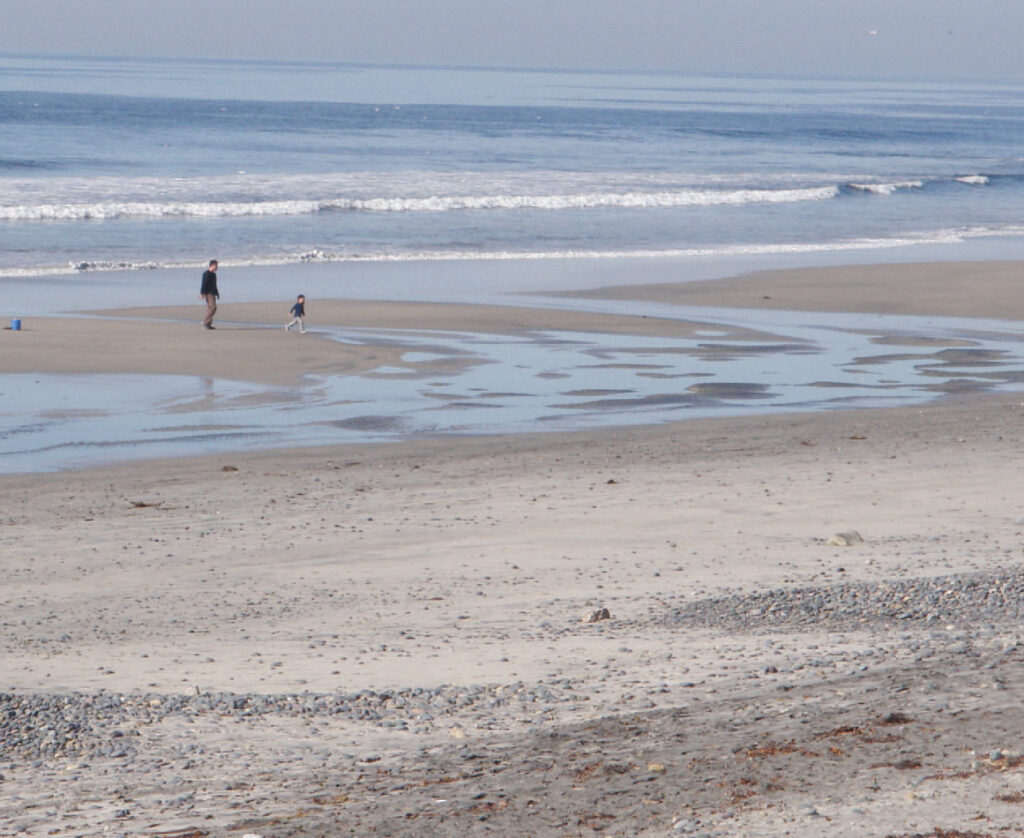
Troughs and Cuts
Troughs are highways that lead fish to and from feeding areas. A smaller trough could be defined as a “cut,” but nonetheless, both of these features play a vital role in fishing the beach, and both tend to run perpendicular to the shore (although not always — for example, they may run along structure, such as a jetty). Incoming and outgoing tides move water through these highways and bring along with them a smorgasbord of helpless organisms, and like a street gang of Hell’s Angels, surfzone predatory fish cruise them looking to pounce on something. Troughs and cuts can be identified by their darker tint, ranging from blue to green, compared with the surrounding, shallower water. Often, when fishing a trough, I cast my fly quartering “downstream,” so to speak. On an outgoing tide, water will get sucked out of the trough, creating a strong current, much like the flow of a trout stream. I allow my fly to sink with a couple of long mends thrown into my line after the cast. As the fly line swings, I begin a series of short, quick strips to animate the fly, then hold on and prepare for a jolting grab.
Drop-Offs
A drop-off is where shallow water meets deep water. A drop-off can come in the form of a long ledge a hundred yards in width or be only 10 to 15 feet wide. Like other important structure off the beach, drop-offs provide shelter from deep-water predators while allowing for prime ambush locations. As an incoming tide begins to rise, fish position themselves near the drop-offs in the deeper water and feed on unsuspecting baitfish, crabs, clams, and shrimp. Exploring your local beaches at extreme low tides will often expose drop-offs that otherwise might go undetected. There are other ways to locate drop-offs, as well. First, as when spotting cuts and troughs, I look for color changes in the water. Deeper water will be darker, although this change in color can be very subtle. A pair of polarized sunglasses is a must for recognizing contrasting shades of water, as well as for eye protection from wind-blown casts.
Second, while wading and searching for likely spots, I often encounter a dropoff by simply stepping off a ledge into deeper water. Just a small change in elevation in the sand will create a holding spot for fish. If I step off a ledge, I back up and fish the area until I get a hit.
The third way I find drop-offs is by feeling my fly tick or not tick the bottom or by unusual drag on the fly line. A few months back, I luckily stumbled upon a small ledge while prospecting for surfperch in front of the Hotel del Coronado. It was afternoon, the tide was coming in, and I had not hooked a fish in the short amount of time that I had been there. As I covered the area with 60-foot blind casts, I noticed that my fly line would start to drag in the sand about 20 feet from me. In the tumultuous surf environment of everchanging currents, very seldom does my line actually drag in the sand. I figured there must be a small drop-off there and proved my deduction to be correct by wading out 20 feet and stepping off a twoand-a-half-foot ledge. After retreating to shallower water, I was rewarded with a perch on my third cast to that ledge.
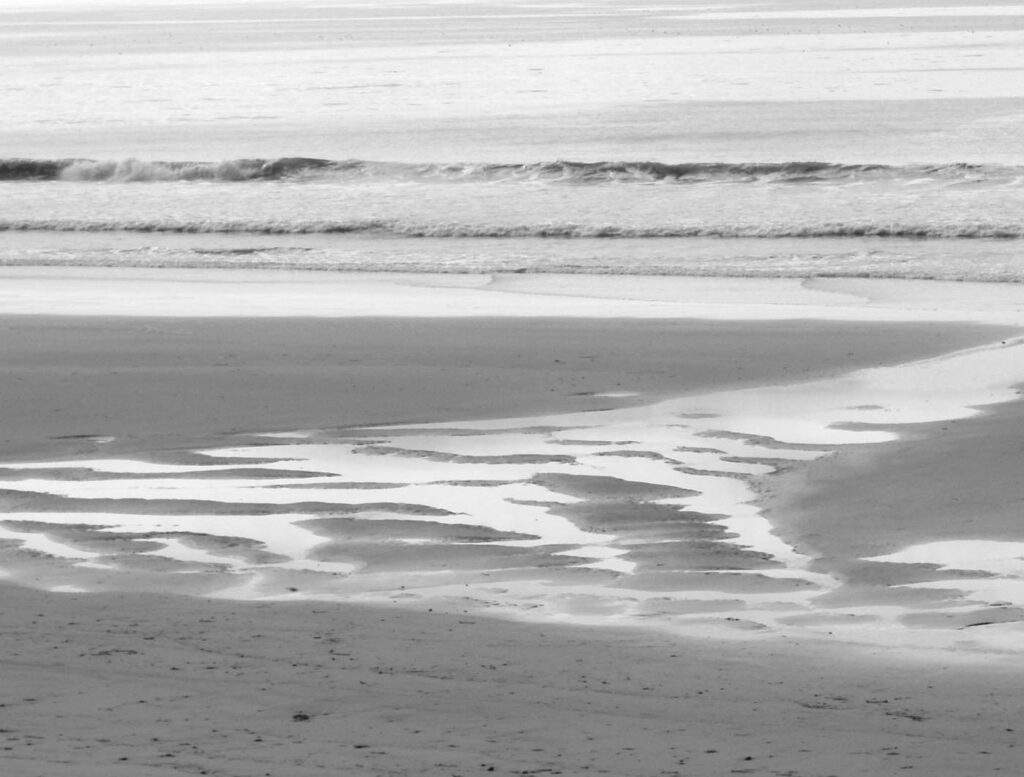
Seams
Seams are created when two or more currents converge in the surf zone. These currents can be seen by keeping a close eye on the frothy, floating foam that is blended up by the constant smashing of waves into the sand. I watch the foam to see which way the current is pushing it and then slowly scan the water to find where there is a current pushing in the opposite direction. Where the currents meet, the seam forms a funnel, pushing bait and crustaceans right through them, and fish stack up there, waiting for easy meals. Other areas to find currents converging include along rock outcroppings such as jetties and breakwalls and under and around bridge pilings, piers, and docks.
Fly Lines
In addition to knowing where to locate fish in the surf zone, it is equally important to know how to get your fly in front of the fish. Because of the harsh, turbulent environment, fish in the surf hang near the bottom, and a fast-sinking, shooting head ideally suits the surf. Here in Southern California, I recommend a 200grain or 250-grain line rigged on a 5weight to 7-weight rod. (You may need to go heavier in the rougher surf of Northern California.) The days of having only the option of a lead-core shooting head attached to a monofilament running line with loops or knots are gone. Most fly-line manufacturers now offer seamlessly integrated shooting heads and lines with a 25-foot or 30-foot sinking section and a 70-foot running line. These lines are a dream to cast and get the fly down into the strike zone.
I’ve had more than one stubborn friend, when first starting to fish off the beach, refuse to cast sinking lines, choosing instead to fish with a full floating line. After continually getting outfished, they all finally made the transition to sinking lines and had much more success. You can catch fish in the surf on a floating line, but it is important to remember that most of the turbulence, the “washing machine” effect created by the waves and the intense pushing and pulling of various currents, is near the top of the water column. That’s why the fish hug the bottom. Like trout in a river, they won’t waste precious energy swimming in fast water. Instead, they seek out moving water that delivers food to them, but doesn’t require them to expend a lot of calories. A floating fly line very seldom allows the fly to be in the strike zone.
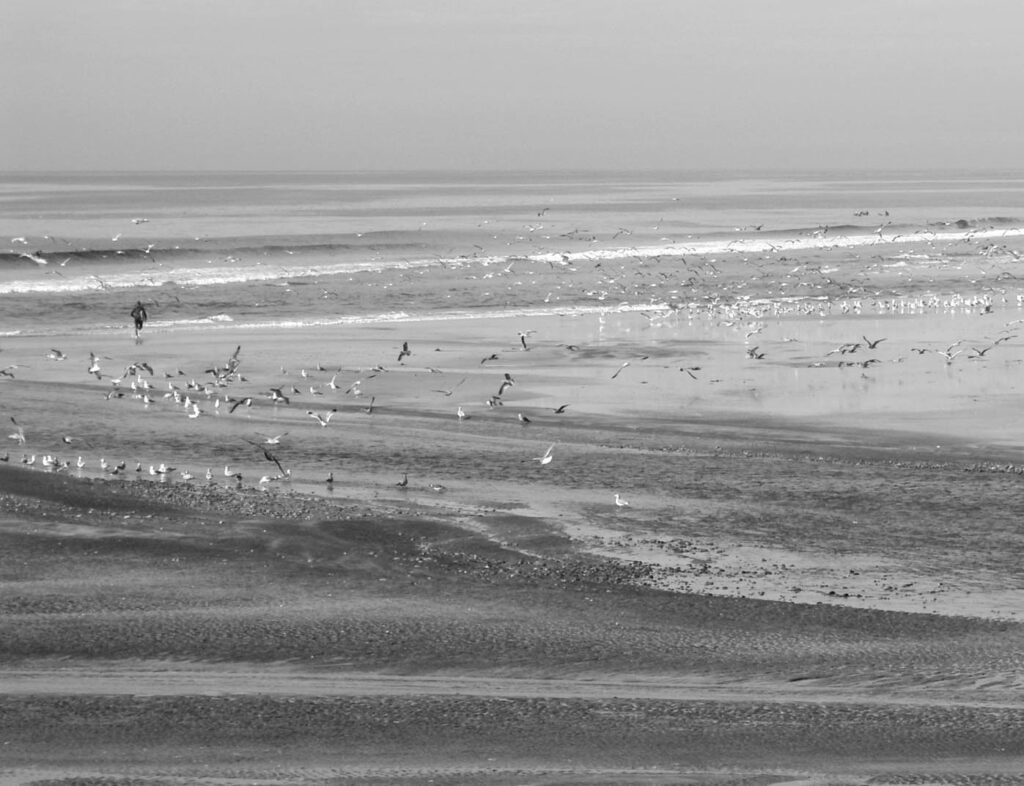
Flies
Surf-zone fish are highly opportunistic feeders, especially surfperch. With all the complex currents, fish have little time to scrutinize food and flies. Matching the hatch, so to speak, is not necessary in this environment. Instead, use impressionistic flies. Bonefish-style flies are always effective — they’re the proper size and generally resemble the critters that live in the sand. Crazy Charlies, Clouser Minnows, Beck’s Sili-Legs, and Raghead Crabs in sizes 4 and 6 rank among my favorites. Also, over the last several years, there’s been a select group of pioneering beach anglers up and down the coast of California tying new flies specifically designed for our surf zone. Many of the major fly-tying manufacturers have begun selling these patterns to fly shops throughout the state, so I encourage you to visit your local shop and ask for what’s new in surf flies.
Other Gear
When fishing Southern California’s beaches, I highly recommend wearing waders during the winter and spring (they’re pretty much required year round in the northern part of the state). Staying dry and warm is essential to having comfortable experiences fishing along the beach. Breathable waders work best, and the amount and type of layered clothing under your waders depends on the weather and the water temperature. Flats-type boots — the same kind used for bonefishing — are perfect for walking and wading sandy beaches. Leave the felt-soled boots at home. Sand and grit will get in between the sole and the felt, causing them to separate.
A rain jacket is critical. Regardless of the weather, surf anglers are constantly battered by salt spray from the breaking waves. A waterproof, breathable jacket keeps you dry, and dry, warm, comfortable anglers fish longer and more diligently — and have a lot more fun in the process.
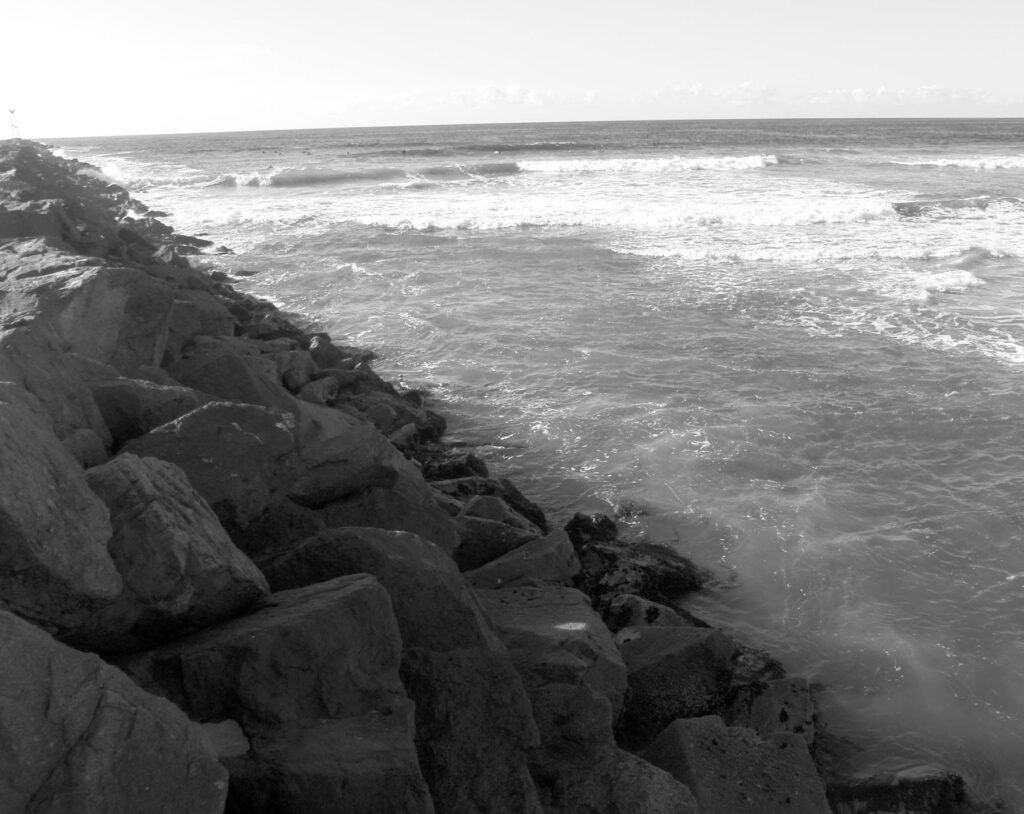
Other essential equipment includes a pair of polarized sunglasses, as I mentioned, plus a stripping basket for managing your fly line and a chest pack for storing extra leaders, tippet material, fly boxes, hemostats, and a hook sharpener. As for leaders, keep them simple and short. I use a leader of 5 or 6 feet tapered to an 18-to22-inch 6-pound-test fluorocarbon tippet. I prefer fluorocarbon tippets because they are less visible than monofilament, but more importantly, because they are much more abrasion resistant.
The type of fish you’ll most likely tangle with while fishing off the beach in the winter and spring is the barred surfperch. Perch resemble their freshwater cousins, bluegills and crappies. In fact, my friend Nick Curcione has for the longest time referred to surfperch as “bluegills on steroids.” These powerful fish reside in the surf year-round, searching for crabs, shrimp, clams, and other tiny morsels that the waves churn up. Surfperch are plentiful, and anglers who understand the game often hook a dozen or more fish in a morning or evening session. The average fish is about the size of your hand, but dinnerplate-sized fish are commonly caught, especially during low-light conditions. I refer to these big fish as “grandes,” and pound for pound, they’ll pull harder than almost any other fish in the surf zone.
The constant crashing of waves into the California coast and the power produced by these waves has created the beaches that we see today. Sometimes this saltwater environment can get downright nasty, with large breaking waves pounding the sand, which can be intimidating to an angler fishing on foot. I can’t emphasize enough, though, that if you set aside your fears and get your feet wet in the world of surf fishing, you’ll be surprised what you might end up battling on the long rod.



